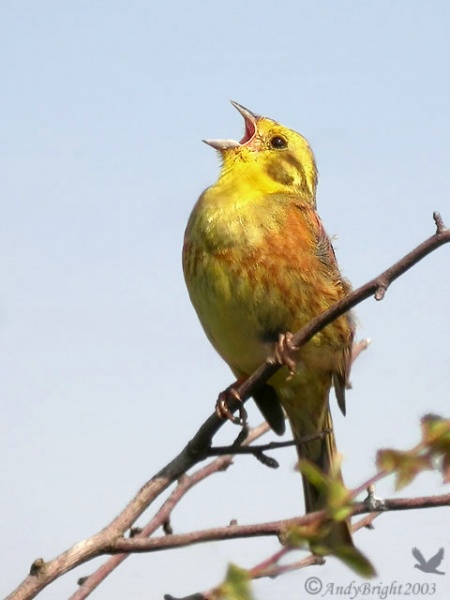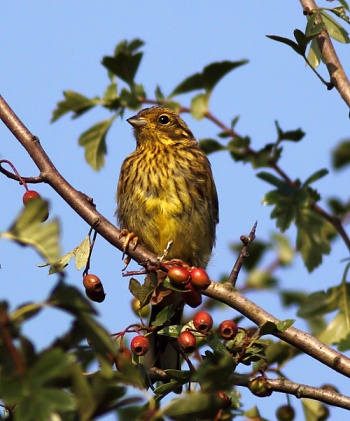- Emberiza citrinella
Identification
16–16·5 cm (6¼-6½ in).
Fairly big and long-tailed with unmarked red-brown rump and elements of yellow in plumage. Mantle/back olive-brown, heavily streaked black. Bill rather small, lower mandible light blue-grey. Much white on tail-corners, often seen in flight, when looks longer-tailed than e.g. Reed Bunting.
Summer Male: Unmistakable, having almost entirely yellow head with just a few dark markings on crown- and head-sides. Saturated yellow below, with much olive-green and red-brown on breast and with flanks streaked red-brown
Summer Female: Greyish-green, streaked crown, at times with a small yellow spot; grey-green head-side with no yellow. Underparts paler yellow, with greyish-black streaking on breast and flanks.
Autumn: often told by intimation of deep yellow on head and underparts, and by olive-green and red-brown colour on breast, rather like summer.
1st-winter often has almost wholly brown and streaked head and buff-white underparts with only faint yellow tinge; note: yellow on underparts can be hard to spot in field.
Distribution
Predominantly resident, but many Scandinavian birds migrate Oct-mid Nov to North Sea countries, returning March/April.
Taxonomy
Subspecies
There are 3 subspecies[1]:
- E. c. caliginosa:
- E. c. citrinella:
- E. c. erythrogenys:
Habitat
Breeds commonly in farmland, in bushy areas, woodland edge and wooded pasture, in glades and clearings, on heaths and coastal meadows.
Behaviour
Wary without being really shy, usually flushes early; often gains height, perches high in tree or drops into thick bushes.
Flight
Flight in long undulations and slightly jerky.
Diet
The diet includes insects when feeding young, and otherwise seeds.
Breeding
The cup shaped nest, built by the female, from grass and moss, and lined with hair and grass. It is usually on the ground amidst hedgerows, grasses, or shrubs. The 3-6 smooth, glossy and white with few purplish markings eggs are incubated by the female. Both parents feed the young.
Vocalisation
References
- Clements, J. F., T. S. Schulenberg, M. J. Iliff, S. M. Billerman, T. A. Fredericks, B. L. Sullivan, and C. L. Wood. 2019. The eBird/Clements Checklist of Birds of the World: v2019. Downloaded from http://www.birds.cornell.edu/clementschecklist/download/
Recommended Citation
- BirdForum Opus contributors. (2025) Yellowhammer. In: BirdForum, the forum for wild birds and birding. Retrieved 16 May 2025 from https://www.birdforum.net/opus/Yellowhammer
External Links
GSearch checked for 2020 platform.1






